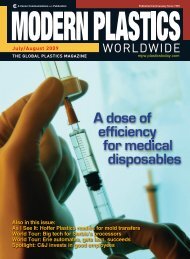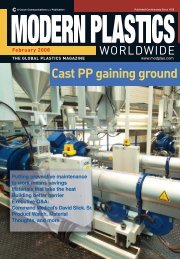amidiq - dae uptlax
amidiq - dae uptlax
amidiq - dae uptlax
Create successful ePaper yourself
Turn your PDF publications into a flip-book with our unique Google optimized e-Paper software.
292<br />
F. J. Valdés-Parada y col. / Revista Mexicana de Ingeniería Química Vol. 6, No. 3 (2007) 283-294<br />
1<br />
m ( ) = ⎡ 0ν( 0, 1( 0) ,..., ( 0)<br />
)<br />
cj x ∫ 0 ⎣<br />
x jR x c x cn x<br />
(71)<br />
G( x, x0) ⎤⎦ d x0 + cs, j = 1,..., m<br />
En otras palabras, el resultado es ahora un<br />
sistema de ecuaciones integrales acopladas no<br />
lineales, el cual puede resolverse mediante métodos<br />
iterativos de inversión de matrices. Cabe mencionar<br />
que en la Ec. (71), G(x, x0) está dada en los<br />
resultados de la Tabla 1 ya que el problema de valor<br />
a la frontera asociado para la función de Green es<br />
idéntico al expresado en las ecs. (13)-(15).<br />
Por último, cabe mencionar que en todos los<br />
problemas que se abordaron en este trabajo, tanto el<br />
dominio como las fronteras no involucraron<br />
considerar ningún tipo de discontinuidad. Si este<br />
fuera el caso, debe tomarse en cuenta que la fórmula<br />
de Green [Ec. (21)] es el resultado de integrar la<br />
identidad de Lagrange [Ec. (20)]. De manera que si<br />
hubiese discontinuidades, se podría descomponer el<br />
dominio de integración en un número finito de<br />
subdominios en los cuales los integrandos fuesen<br />
continuos. Sin embargo, este tema sobrepasa los<br />
objetivos de este trabajo y serán abordados en<br />
trabajos futuros.<br />
Conclusiones<br />
En este trabajo se ha explorado la habilidad<br />
que tienen formulaciones integrales basadas en<br />
funciones de Green para proveer soluciones<br />
numéricas confiables de modelos de transporte de<br />
masa y reacción. Las simulaciones numéricas,<br />
ilustran que, comparado con el método clásico de<br />
diferencias finitas, la formulación integral ofrece<br />
mejores propiedades de convergencia bajo un rango<br />
considerable de valores de parámetros<br />
macroscópicos. De hecho, de acuerdo a los<br />
resultados de la Sección 3, se puede afirmar que con<br />
la metodología propuesta se obtienen predicciones<br />
aceptables del factor de efectividad usando, en<br />
general, menor número de nodos computacionales y,<br />
por tanto, menor tiempo de cómputo. Esto se debe<br />
principalmente a dos factores que son el suavizado<br />
de los errores de redondeado en el paso de<br />
integración y a la incorporación en forma exacta de<br />
las condiciones de frontera. Además, la estructura de<br />
la ecuación integral, ofrece una mejor comprensión,<br />
tanto física como matemática, de la solución de los<br />
problemas de valor a la frontera.<br />
Agradecimientos<br />
FJVP desea agradecer al Consejo Nacional de<br />
Ciencia y Tecnología (CONACyT) por la beca de<br />
posdoctorado otorgada a través del convenio 49705-<br />
Y.<br />
Referencias<br />
Alvarez-Ramirez, J., Valdés-Parada, F.J., Alvarez, J.,<br />
Ochoa-Tapia, J.A. (2007). A Green's function<br />
formulation for finite difference schemes.<br />
Chemical Engineering Science 62, 3083-3091.<br />
Amundson, N.R., Schilson, R.E. (1961). Intraparticle<br />
reaction and conduction in porous catalysts-I.<br />
Single reactions. Chemical Engineering<br />
Science 13, 226-236.<br />
Aris, R. (1975). The Mathematical Theory of<br />
Diffusion and Reaction in Permeable<br />
Catalysts, Vol. I. Clarendon Press, Oxford.<br />
Axelsson, O., Gololobov S.V. (2003). A combined<br />
method of local Green's functions and central<br />
difference method for singularly perturbed<br />
convection-diffusion problems. Journal of<br />
Computational and Applied Mathematics 161,<br />
245-257.<br />
Denn, M.M., Aris, R. (1965a). Green's Functions and<br />
Optimal Systems. Necessary Conditions and<br />
Iterative Technique. Industrial and<br />
Engineering Fundamentals 4, 7-16.<br />
Denn, M.M., Aris, R. (1965b). Green’s functions and<br />
optimal systems. The gradient direction in<br />
decision space. Industrial and Engineering<br />
Fundamentals 4, 213-222.<br />
Denn, M.M., Aris, R. (1965c). Green's Functions and<br />
Optimal Systems. Complex Interconnected<br />
Structures. Industrial and Engineering<br />
Fundamentals 4, 248-257.<br />
Dixit, R.S., Tavlarides L.L. (1982). Integral analysis<br />
of Fischer-Tropsch synthesis reactions in a<br />
catalyst pellet. Chemical Engineering Science<br />
37, 539-544.<br />
Greenberg, M.D. (1971). Application of Green’s<br />
Functions in Science and Engineering.<br />
Prentice-Hall, New York.<br />
Kesten, A.S. (1969). An integral equation method for<br />
evaluating the effects of film and pore<br />
diffusion of heat and mass on reaction rates in<br />
porous catalyst particles. AIChE Journal 15,<br />
128-131.<br />
Haberman, R. (2004). Applied Partial Differential<br />
Equations, 4 th edition, Prentice Hall, USA.<br />
Mishra, M., Peiperl L., Reuven Y., Rabitz H., Yetter<br />
R.A., Smooke M.D. (1991). Use of Green's<br />
functions for the analysis of dynamic<br />
couplings: Some examples from chemical<br />
kinetics and quantum dynamics. Journal of<br />
Physical Chemistry 95, 3109-3118.<br />
Mishra M., Yetter R., Reuven Y., Rabitz H.,<br />
Smooke M.D. (1994). On the role of transport<br />
in the combustion kinetics of a steady-state<br />
premixed laminar CO + H₂ + O₂ flame.<br />
International Journal of Chemical Kinetics<br />
26, 437-453.<br />
Mukkavilli S., Tavlarides, L.T. & Wittmann, Ch.V.<br />
(1987a). Integral method of analysis for<br />
chemical reaction in a nonisothermal finite









